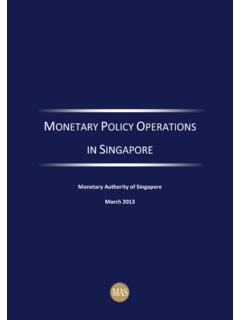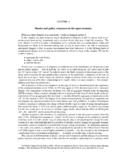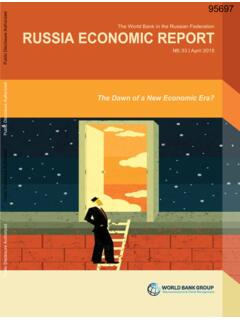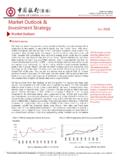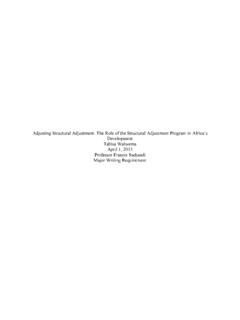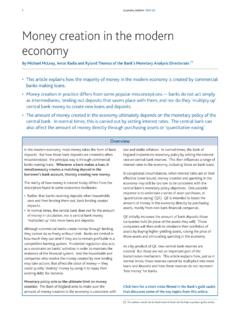Transcription of BIS Working Papers
1 BIS Working Papers No 628 Is monetary policy less effective when interest rates are persistently low? by Claudio Borio and Boris Hofmann monetary and economic Department April 2017 JEL classification: E43, E52 Keywords: monetary policy , low interest rates, balance-sheet recession, monetary transmission BIS Working Papers are written by members of the monetary and economic Department of the Bank for International Settlements, and from time to time by other economists, and are published by the Bank. The Papers are on subjects of topical interest and are technical in character. The views expressed in them are those of their authors and not necessarily the views of the BIS. This publication is available on the BIS website ( ). Bank for International Settlements 2017. All rights reserved.
2 Brief excerpts may be reproduced or translated provided the source is stated. ISSN 1020-0959 (print) ISSN 1682-7678 (online) WP628 Is monetary policy less effective when interest rates are persistently low? i Is monetary policy less effective when interest rates are persistently low? Claudio Borio and Boris Hofmann1 Abstract Is monetary policy less effective in boosting aggregate demand and output during periods of persistently low interest rates? This paper reviews the reasons why this might be the case and the corresponding empirical evidence. Transmission could be weaker for two main reasons: (i) headwinds, which would typically arise in the wake of balance sheet recessions, when interest rates are low; and (ii) inherent non-linearities, which would kick in when interest rates are persistently low and would dampen their impact on spending.
3 Our review of the evidence suggests that headwinds during the recovery from balance-sheet recessions tend to reduce monetary policy effectiveness. At the same time, there is also evidence of inherent non-linearities. That said, disentangling the two types of effect is very hard, not least given the limited extant work on this issue. In addition, there appears to be an independent role for nominal rates in the transmission process, regardless of the level of real (inflation-adjusted) rates. JEL classification: E43, E52 Keywords: monetary policy , low interest rates, balance-sheet recession, monetary transmission 1 Bank for International Settlements. E-mail addresses: and The paper was prepared for the Reserve Bank of Australia conference monetary policy and Financial Stability in a World of Low Interest Rates , 16 17 March 2017, Sydney.
4 We thank the conference organisers for posing the question addressed in the paper and Raphael Auer, Dietrich Domanski, Thorsten Ehlers, Andrew Filardo, Leonardo Gambacorta, Jonathan Kearns, Emanuel Kohlscheen, Marco Lombardi, Jouchi Nakajima, our discussant Bruce Preston, Phurichai Rungcharoenkitkul, Hyun Song Shin, James Yetman, seminar participants at the BIS and the conference participants at the RBA for helpful comments. Amy Wood provided excellent statistical support. The opinions expressed in this paper are those of the authors and do not necessarily reflect those of the Bank for International Settlements. WP628 Is monetary policy less effective when interest rates are persistently low? iii Contents Introduction .. 1 1. Lower monetary policy effectiveness? Potential mechanisms .. 4 Headwinds.
5 4 Nonlinearities linked to the level of interest rates .. 6 Net interest margins, bank profitability and bank lending .. 6 Consumption and saving .. 7 Uncertainty .. 9 Resource misallocation .. 9 2. The evidence .. 10 Headwinds .. 11 Nonlinearities linked to the level of interest rates .. 15 Net interest margins, bank profitability and bank lending .. 15 Consumption and saving .. 18 Resource misallocation .. 20 Conclusion .. 21 References .. 22 WP628 Is monetary policy less effective when interest rates are persistently low? 1 Introduction Interest rates in the core advanced economies have been persistently low for about eight years now (Graph 1). Short-term nominal rates have on average remained near zero since early 2009 (left-hand panel) and have been even negative in the euro area and Japan, respectively, since 2014 and 2016.
6 The drop in short-term nominal rates has gone along with a fall in real (inflation-adjusted) rates to persistently negative levels. Long-term rates have also trended down, albeit more gradually, over this period: in nominal terms, they fell from between 3 4% in 2009 to below 1% in 2016, on average (Graph 1, centre panel); in real terms, they have been mostly negative since 2012. Indeed, following the adoption of negative policy rates in the euro area, Japan and some smaller advanced economies, at the end of 2016 a significant stock of global government bonds (more than $7 trillion or 20% of the total outstanding)2 was still trading at negative yields, after reaching a peak of over $10 trillion in mid-2016. For all its prominence, the post-US election backup in yields has so far not fundamentally changed this picture.
7 From a historical perspective, this persistently low level of short- and long-term nominal rates is unprecedented. Since 1870, nominal interest rates in the core advanced economies have never been so low for so long, not even in the wake of the Great Depression of the 1930s (Graph 2, top panels). Elsewhere, too, including in Australia, short- and long-term interest rates have fallen to new troughs, reflecting in part global interest rate spillovers especially at the long end (Obstfeld (2015), and Hofmann and Tak ts (2015)). 2 The numbers refer to the sovereign bonds represented in the Merrill Lynch World Sovereign index. Low interest rates in core advanced economies Graph 1 Short-term interest rates1 Long-term interest rates2 Stock of government bonds with negative yields3 Per cent Per cent USD trn 1 Simple average of Japan, euro area, the United Kingdom and the United States.
8 2 Simple average of France, the United States and the United Kingdom. 3 Based on the constituents of the Bank of America Merrill Lynch World Sovereign index. 4 Nominal policy rate minus CPI inflation (for the United States, PCE inflation); long-term index-linked bond yield. Sources: Bank of America Merrill Lynch; Bloomberg; Datastream; BIS calculations; national data. 2 WP628 Is monetary policy less effective when interest rates are persistently low? The picture is not very different for interest rates measured in real or inflation-adjusted terms (Graph 2, bottom panels). To be sure, there have been periods during which, as a result of high inflation, real rates have been even lower, notably during the Great Inflation of the 1970s. But recently real rates have generally been negative for even longer than at that time. The persistently low rates of the recent past have reflected central banks unprecedented monetary easing to cushion the fallout of the Great Financial Crisis (GFC), spur economic recovery and push inflation back up towards objectives.
9 However, despite such efforts, the recovery has been lacklustre. In the core economies, for instance, output has not returned to its pre-recession path, evolving along a lower, if anything flatter, trajectory, as growth has disappointed (Graph 3). At the same time, in many countries inflation has remained persistently below target over the past three years or so (Graph 3). Against this background, there have been questions about the effectiveness of monetary policy in boosting the economy in a low interest rate environment. This paper assesses this issue by taking stock of the existing literature. Specifically, the focus is on whether the positive effect of lower interest rates on aggregate demand diminishes when policy rates are in the proximity of what used to be called the zero Interest rates, 1870-2016 In per cent Graph 2 Nominal short-term rates Nominal long-term rates Real short-term rates1 Real long-term rates1 1 Nominal interest rate minus CPI inflation.
10 Sources: Jord , Schularick and Taylor (2017); Global Financial Data; national data. WP628 Is monetary policy less effective when interest rates are persistently low? 3 lower bound. Moreover, to keep the paper s scope manageable, we take as given the first link in the transmission mechanism: from the central bank s instruments, including the policy rate, to other rates. The extensive literature on this question has already been reviewed elsewhere (eg Borio and Zabai (2016)). And we focus exclusively on domestic transmission channels, thereby excluding the impact through the exchange We review the conceptual arguments and empirical evidence. Conceptually, monetary policy transmission may be weaker when interest rates are low for at least two reasons. The first has to do with the economic context: macro-financial headwinds may blow more strongly when interest rates are low.











